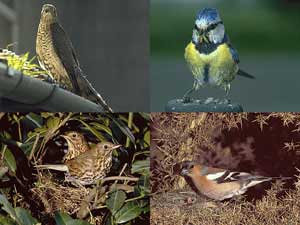Although we have looked at food chains as a way of examining the passage of energy from the Sun into higher organisms, the inter-relationship between different organisms is never that simple. Frequently a number of food chains have species in common producing a 'food web'. For example, looking back at our food chain - other organisms, such as ladybirds, feed on aphids; sparrowhawks prey on more than just blue tits. Some food webs can be extremely complex, but all of them have three groups of organism - 'producers' (some sort of green plant), 'primary consumers' (those organisms which feed on green plants) and 'secondary consumers' (those organisms which feed on other animals).
|
|

Sparrowhawks prey on other birds, such as chaffinches and thrushes as well as blue tits. This expands a simple food chain into a food web, with many different organisms involved.
|

![[Advert]](../../images/ad/content.gif)

![[Advert]](../../images/ad/content.gif)